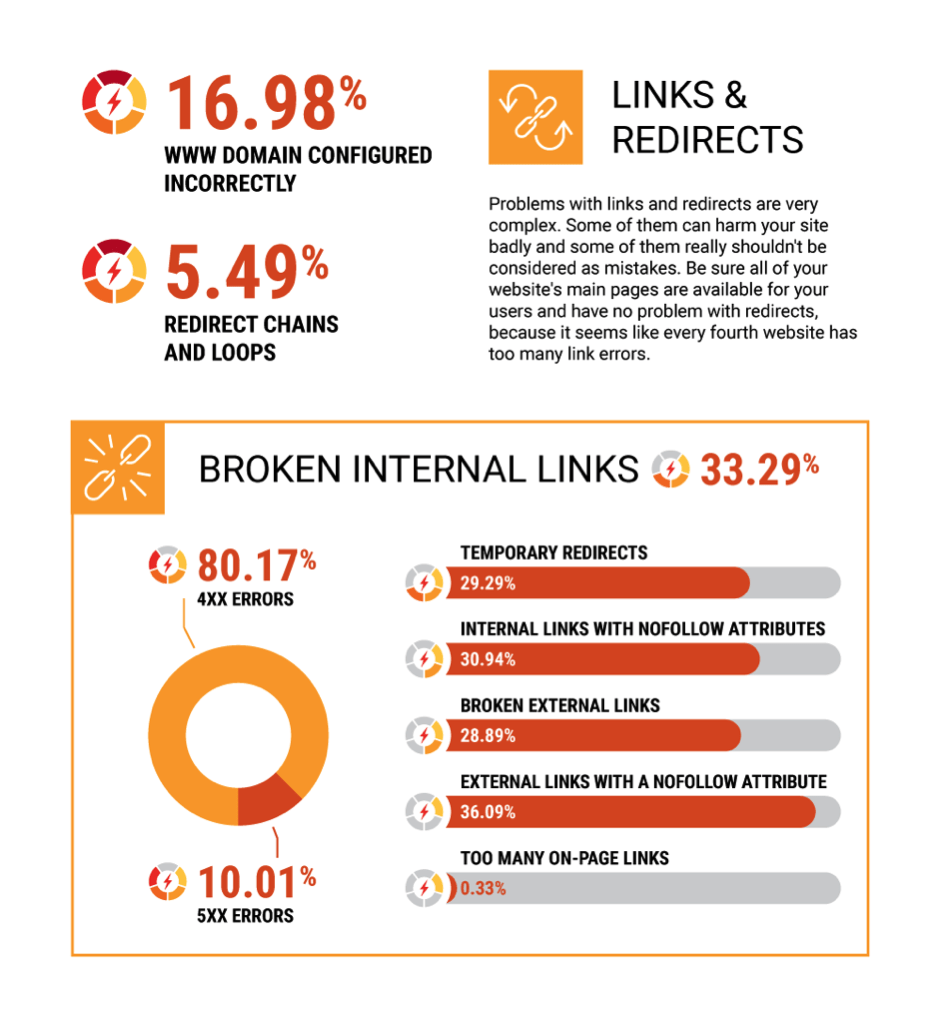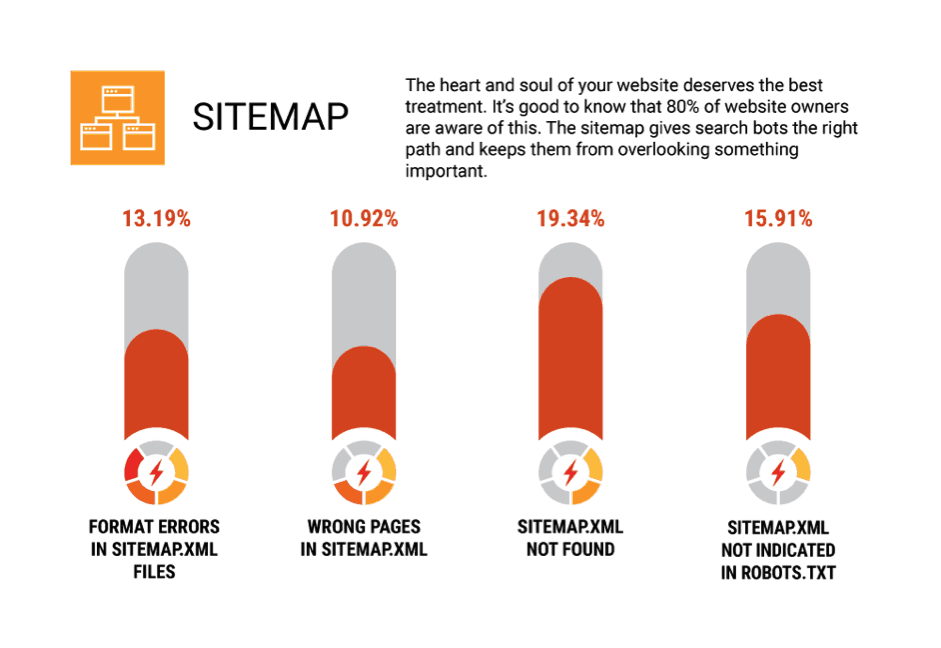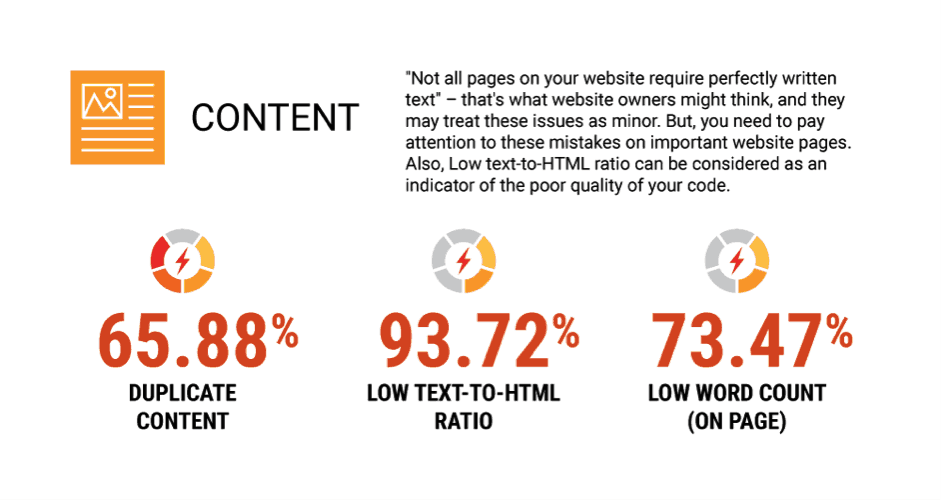Think of technical SEO as your website’s skeleton. Anything that grows on its bones will be affected by the way they are shaped.
But when it comes to technical SEO, it’s often hard to determine where you should start with and what SEO mistakes you should look at first.
Thus, SEMrush (disclosure: I work for SEMrush) conducted some research on the most frequent and harmful SEO issues that negatively affect a website’s performance.
For the study, we collected data on 100,000 websites and 450 million pages to identify the most common technical SEO mistakes and assigned a severity level to each issue. These are the factors that determine your website’s user-friendliness and thus, its overall performance.
It’s important to look at all the issues we discuss below to get a thorough insight into your website’s health. Do make sure that you prioritize the errors made on the most important pages of your website, as, not every mistake needs to be fixed right away. Which is why we are not simply giving you insights on the most common SEO mistakes but are also listing them in regards to how much they affect your website’s performance.
Most Common Technical SEO Issues & Their Severity
At large, there are three layers each website owner should consider in order to evaluate their website’s health:
- Crawlability & Site Structure
- On-Page SEO
- Technical SEO
Each area is like Pandora’s box – once opened, it releases various evils that you will have to deal with. But let’s take it one step at a time.
Area 1: Crawlability & Site Structure
Optimization efforts are only effective when search engines have access to your webpages. The Googlebot has to crawl and index your entire website before it appears in SERPs. So, any error at this point will simply bring all of your optimization efforts to naught.
The Main Crawlability & Site Structure Errors You Should Avoid
Links & Redirects
SEMrush found that every fourth website has link errors, while domain configuration and errors in redirect chains and loops are among the less common but harmful issues.
The biggest problems occur in the internal links – 30 percent of websites have broken internal links.
Also, pay extra attention to 4XX errors – they are present among 26.5 percent of websites.
You can see a more detailed breakdown in the image below:

While links and redirects make up the pathways to your user’s journey through your website, it’s still important to correctly configure your map. As such, let us look at what sitemap and robots.txt have to do with crawlability and site structure.
Sitemap & Robots.txt
Although most websites appear to do pretty well when it comes to sitemaps and robots.txt’s, some issues are still quite severe.
Check whether you have any format errors in your sitemap.xml files – which affect about 13 percent of websites, or any format errors in your robot.txt, which is a less common yet equally severe mistake.
Make sure that, if spotted, these issues are resolved in the first instance.

Area 2: On-Page SEO
Now it’s time to look at your individual webpages, as this is what on-page optimization is all about. This area is of the utmost importance to your valuable pages.
Basically, on-page SEO is all about optimizing content and the HTML code of particular pages to improve their rankings; and a well-optimized page will naturally have a better off-page performance.
Key On-Page SEO Errors to Watch out For
Content
Content is pretty much everything! And it is not only true about the actual quality of your content, but also about its technical aspects.

In fact, most technical SEO issues come from content:
- 65.88 percent of websites have severe duplicate content issues. Of course, in some cases, it’s impossible to avoid having duplicate content, but you can always add a rel=”canonical” tag to your secondary pages. However, try not to overuse your page-concealment powers, as unique content is always better than well-optimized duplicate content.
- An impressive 93.72 percent of webpages have a low text-to-HTML ratio. While this issue is really widespread, its severity level is pretty low because some pages (e.g., a “Contact Us” page) will naturally contain less text. However, this will still be perceived as an error.
- 73.47 percent of pages have a low word count, which isn’t always a wrongdoing on your part, as some webpages simply do not require much text. While this may be a minor error, attempt to put at least 250 words on each page where it is appropriate and feels natural.
However, on-page SEO does not stop once you optimize your content. Furthermore, you have to optimize the page, containing that very content, for web search. And this is where meta descriptions, title, headings and images enter the stage.
Meta Descriptions
As shown by the study, meta descriptions are often left out from the optimization process. 63 percent of website owners completely abandon any efforts to create a meta description, and almost 54 percent of websites have duplicates.
Duplicate meta descriptions are highly severe while missing ones aren’t that harmful because search engines will assign a meta description – even if you don’t take the time to do it yourself. But, it is often a bad idea to leave everything up to the search engine.
After all, the meta description is a display window to your website – it’s what makes people click. So if you want a higher click-through rate (CTR) for your webpages, pay attention to it!
 Title Tags, H1 Tags & Images
Title Tags, H1 Tags & Images
Another area of content optimization that affects your SEO has to do with titles, headings, and images.
More than 60 percent of websites are missing alt tags for their images, have title tags that are too long, and are lacking H1 tags.
While these issues aren’t considered to be as severe as many others, they do negatively affect your website’s UX, which, in turn, has a negative impact on your rankings.
Area 3: Technical SEO
You must now be wondering why we left out such significant areas of SEO like site speed and mobile responsiveness. The macro indicators of your website’s performance are in the technical SEO section.
The price of a mistake in any of the technical SEO components can be incredibly high. An Amazon study revealed that 100 milliseconds of extra load time can cause a 1 percent drop in sales.
However, it seems that most website owners have got technical SEO covered. But if you are faced with any of the issues below, you should know that fixing them will affect your entire website’s performance, rather than just a single page.
Your Traffic & Revenue Largely Depend on the Following Technical SEO Areas
Page Speed
Page speed is one of the most significant Google ranking factors, influencing user experience and, therefore, affecting metrics like bounce rate. More than 20 percent of websites have a slow page load speed, an issue that deserves the highest level of severity.
While page load speed depends on various factors, having a modern website can significantly improve the situation.

Old Technology
Would you notate complex mathematical formulas using Roman numerals? Probably not.
So, don’t assume that search engines want to read old technology: things like Iframes and Flash content are severe issues that still appear on a few websites.
The Internet never stops evolving, meaning many technical aspects become obsolete. Hence, your job is to simply try to keep up with all the changes.
However, the oldest technology we can now think of is having a website that is not mobile-responsive.
 Mobile-Friendliness
Mobile-Friendliness
Although many websites have already embraced the Mobilegeddon, it has caused some confusion over the technical side of things.
The worst thing you can do is forget to add a canonical tag in Accelerated Mobile Pages. This is a high-severity issue, present across 0.08 percent of AMP adopters.

Conclusion
The importance of technical SEO can’t be overestimated. However, you don’t have to wage a war on every single issue that occurs on your webpages.
Being aware of the most common technical SEO mistakes will guide you in the right direction if you aren’t certain of where to start. Make sure that you prioritize your most important pages and understand the severity level of each error.
Knowing where many others went wrong, and how bad the effect might be, is already half the battle. After all, forewarned is forearmed.
More SEO Mistakes Resources Here:
- The 10 Most Harmful Mobile SEO Mistakes
- 5 Silly SEO Mistakes That Even Professional Marketers Make
- Top 10 WordPress SEO Mistakes to Avoid
Image Credits
Featured Image & In-post Photos: SEMrush. Used with permission.


